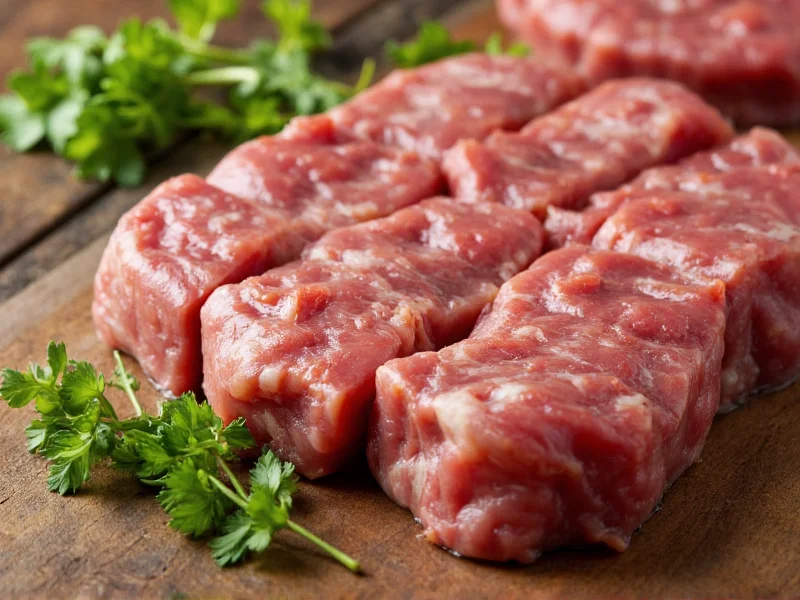The most effective herb and meat pairings combine complementary flavor profiles: rosemary and thyme enhance lamb's richness, sage and thyme balance pork's fattiness, tarragon and dill elevate fish, while oregano and marjoram intensify tomato-based beef dishes. Understanding these natural flavor affinities transforms ordinary meals into culinary experiences through chemical interactions between herb compounds and meat proteins.
Mastering herb and meat combinations elevates home cooking from mundane to memorable. The art of pairing isn't arbitrary—it's rooted in flavor chemistry where volatile compounds in herbs interact with meat proteins during cooking. This guide explores evidence-based pairings that maximize taste, tenderness, and nutritional benefits while avoiding common flavor mismatches that can ruin dishes.
The Science Behind Flavor Pairing
Herbs contain essential oils like terpenes and phenols that interact with meat's fat molecules during cooking. Rosemary's carnosic acid binds with lamb's fatty acids, creating complex flavor compounds that simple salt and pepper can't achieve. Understanding these chemical interactions prevents overpowering delicate meats like chicken breast while enhancing robust options like beef brisket.
Essential Herb and Meat Pairing Guide
| Meat Type | Best Fresh Herbs | Best Dried Herbs | Flavor Chemistry Insight |
|---|---|---|---|
| Beef (steak, roast) | Rosemary, thyme, oregano | Marjoram, savory, smoked paprika | Rosemary's camphor notes cut through fat while enhancing umami |
| Lamb | Rosemary, mint, oregano | Thyme, sumac, za'atar | Mint's menthol balances lamb's gaminess without masking flavor |
| Pork | Sage, thyme, fennel fronds | Juniper berries, mustard seed, sage | Sage's tannins react with pork fat creating savory depth |
| Chicken | Tarragon, parsley, chives | Dill, celery seed, lemon pepper | Tarragon's anethole enhances poultry's mild flavor profile |
| Fish | Dill, tarragon, chervil | Fennel seed, dill weed, lemon verbena | Dill's carvone complements fish oils without overwhelming |
Application Techniques for Maximum Flavor
Timing determines whether herbs enhance or dominate. For tough cuts like chuck roast, add hardy herbs like rosemary during cooking to allow flavor penetration. Delicate herbs like basil and cilantro should be added in the final minutes to preserve volatile compounds. When creating herb pastes for meat rubs, combine with acid (lemon juice or vinegar) to help herb compounds bind to meat proteins.
Fresh vs. Dried Herbs: When to Use Each
Fresh herbs provide brighter top notes ideal for finishing dishes, while dried herbs offer concentrated flavors better suited for long cooking. Dried oregano contains 30% more carvacrol than fresh, making it superior for tomato-based beef dishes. However, dried basil loses its delicate flavor compounds, so always use fresh for chicken dishes. Understanding these differences prevents common mistakes like using dried cilantro (which develops unpleasant soapy notes) in salsa verde for grilled meats.
Regional Pairing Traditions Worth Adopting
Global culinary traditions reveal time-tested combinations. French cuisine pairs tarragon with chicken in suprêmes de volaille because the herb's anethole complements poultry without overpowering. Middle Eastern za'atar (thyme, sumac, sesame) creates chemical reactions with lamb that enhance tenderness. Japanese shio kōji (fermented rice seasoning with herbs) breaks down meat fibers while adding complex umami notes. These traditions evolved through generations of practical experimentation with flavor chemistry.
Avoiding Common Pairing Mistakes
Many home cooks make critical errors that diminish results. Never pair mint with lamb and chocolate—a combination that creates unpleasant chemical reactions. Avoid using dried basil in tomato-based beef sauces where fresh provides superior flavor release. Don't marinate fish in strong herbs like rosemary for more than 30 minutes, as the acids can prematurely 'cook' delicate flesh. Understanding these boundaries prevents flavor disasters while encouraging creative experimentation within proven parameters.
Practical Implementation Guide
Start with foundational pairings before experimenting. For weeknight dinners, rub chicken thighs with lemon zest and thyme before roasting. Transform basic hamburgers by mixing minced oregano and garlic into the patties. Elevate pork chops with a simple sage butter finished with lemon juice. These small changes leverage flavor chemistry without requiring advanced techniques. As you gain confidence, experiment with less common combinations like lavender with duck or shiso with beef, always considering the underlying flavor compounds at work.
What's the best herb for grilled steak?
Rosemary provides the ideal pairing for grilled steak due to its high concentration of camphor compounds that complement beef's umami while cutting through fat. Use fresh rosemary sprigs as a basting tool during grilling to impart subtle flavor without overwhelming the meat.
Can I substitute dried herbs for fresh when cooking meat?
Yes, but with important considerations. Use one-third the amount of dried herbs compared to fresh, as drying concentrates flavor compounds. Dried oregano works better than fresh in tomato-based beef dishes, while fresh dill is essential for fish preparations. Never substitute dried for fresh in finishing applications like garnishes.
Why does sage work so well with pork?
Sage contains tannins that interact with pork's fat molecules during cooking, creating complex flavor compounds that enhance rather than mask the meat's natural taste. This chemical reaction also helps break down connective tissues, improving tenderness in cuts like pork shoulder when used in slow cooking applications.
How early should I add herbs when roasting meat?
Add hardy herbs like rosemary and thyme at the beginning of roasting to allow flavor penetration. Delicate herbs including basil and cilantro should be added in the final 10-15 minutes to preserve volatile flavor compounds. For herb crusts, apply during the last third of cooking to prevent burning while allowing adhesion.
Which herbs help tenderize meat naturally?
Pineapple sage, papaya leaf, and ginger contain natural enzymes that break down meat fibers. Use these in moderation in marinades (no more than 2 hours for tender cuts) as over-marinating can create mushy textures. Traditional tenderizing herbs like rosemary work through flavor enhancement rather than enzymatic action.











 浙公网安备
33010002000092号
浙公网安备
33010002000092号 浙B2-20120091-4
浙B2-20120091-4